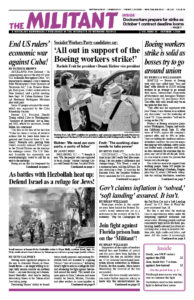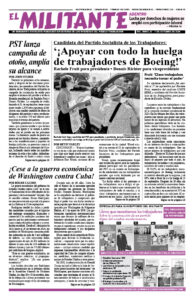Front-page articles in the capitalist press have hailed the Federal Reserve’s recent interest-rate cut as a milestone in the recovery of the U.S. economy. “Pop the Champagne for the Fed Rate Cut and a Soft Landing Ahead” the U.S. News & World Report celebrated Sept. 18.
But this is not what the working class is experiencing today under the deepening capitalist economic and social crisis. Working people confront consistently high prices for food, gas, housing, health care and just about everything else; a drop in available full-time jobs; high credit-card debts; and more. All this makes it increasingly difficult for workers and their families to make ends meet.
“Prices are high on a historical basis,” the New York Times admitted Sept. 20.
The Times claims a key positive feature of the capitalist economy is “public enthusiasm for artificial intelligence.” But there is no “public” enthusiasm, just a hope by capitalist investors that “AI will pay off in profits for big companies,” it admitted. Nvidia — which has been driving the continuing stock market rise, out of whack with the development of the real economy — makes the chips that run the AI chatbots.
But for working people the number employed full time in the U.S. has shrunk by 1.5 million over the past 14 months. At the same time, those taking part-time jobs, with less pay and benefits, increased by 2 million. Millions of workers have been forced to take on a second or even a third job. In August 8.5 million workers were toiling at more than one job.
Unemployment figures have been slowly rising over the past year, as the pace of job creation by employers has fallen under 100,000 a month, half the pace of a year ago. Big retail chain stores have cut back seasonal hiring plans by tens of thousands, fearing lower sales.
With growing numbers of companies reluctant to hire new workers, bosses are pressuring those on the job to produce more in less time, putting workers’ health and safety at risk.
Many fear the Fed’s move will accelerate the jobs crisis. A “soft landing” may be very hard for many workers.
This reality is fueling union fights for significant raises, cost-of-living protection, an end to two-tier divisions, and secure pensions. These fights — from Boeing workers to longshoremen on the East and Gulf coasts — deserve active support from all workers.
High rents, low wages
Continuously high rents and low wages are driving more workers to homelessness. The nearly 800 beds at Atlanta Mission’s network of homeless shelters increasingly include people who have lost a place to live for the first time. Many work jobs but don’t make enough to cover the steep living expenses they and their families face.
“The stories that we hear from our clients: ‘Rent went up, I couldn’t make it,’” Tensley Almand, the organization’s head, told the New York Times. “The number of people underemployed right now, we hear that over and over.” Similar conditions exist in many cities.
More workers are also lining up at food banks, unable to cover the high grocery costs on essential goods. The Greater Boston Food Bank, for example, has delivered more than 100 million pounds of food every year since 2020, up from less than 70 million in 2019.
The monetary manipulations by the Federal Reserve have little impact on the challenges working people face. While rising stock prices have raised the prospects for comfortable retirement for lucky speculators, workers’ real wages have dropped nearly 4% over the past three and a half years.
Ballooning credit-card debt
Credit-card debt keeps rising as more and more workers depend on these cards to cover their expenses. Balances rose to $1.14 trillion in the second quarter, the highest level on record, the New York Fed reported. With annual interest rates averaging over 20% for unpaid balances, delinquencies rose by about 10% over the past year. Delinquencies on auto loans have jumped 8% over the same time period, guaranteeing profits for the repo man.
Some 68 million people in the U.S. receive Social Security, and 40% of them rely on these payments for half or more of their income. While being battered over the past several years by high grocery prices, rents and health and medicine expenses, the cost-of-living increase for 2025 — to be announced in October — is projected to be just 2.5%. And that will be cut by the government’s increase in the cost of Medicare coverage.
This situation has led many retirees to un-retire. Art Barton, 73, retired from a wireless-technology company in Tiburon, California, in 2021, but as prices continued to soar he had to return to working to get by. He told the Wall Street Journal that the costs he faced for home repairs and home insurance premiums had risen over 40%. “It was extremely helpful to go back to work,” he said. He retired again in 2023, hoping he can make it this time.
For many working people, prospects for retirement are a distant dream.

